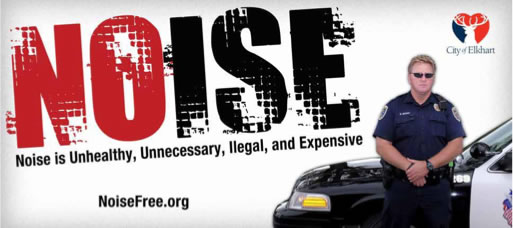Noise: Social and Ecosystem Effects
Excessive noise has many negative impacts on society and ecosystems. Noise may be used as a weapon by law enforcement and the military. Excessive noise is very damaging to communities. Noise is an environmental justice issue. Finally, high noise levels are very damaging to animals, wildlife, and oceans.
Noise as a Weapon
Extreme noise levels can be used as a weapon. In 1989 and 1990, the United States military used constant, hard-rock music to blast Manuel Noriega out of his sanctuary. Loud noise has been used to torture prisoners. The United States military is developing acoustic weapons.
The Missouri Department of Transportation recently introduced a “Long Range Acoustical Device,” which is capable of producing an ear-piercing shriek or siren of 153 decibels, which is beyond the threshold of pain and into the territory that causes permanent hearing damage for the driver and any passengers or nearby vehicles.”
The LRAD Corporation, manufacturer of the noise-making device, asserts that it can “broadcast a loud message in a 15 degree arc over a distance of 1.9 miles. The system was developed for the military for use against terrorists and has been used by law enforcement to disperse crowds of protesters.” Another LRAD system “uses a radar gun to trigger the sound blast in the direction of a vehicle exceeding a certain speed.”
The manufacturer of this technology may not have considered what this loud noise assault could do to the wildlife in these areas. It would probably kill most of them in the area of a mile away. If not, they would have permanently damaged hearing and would not survive long.
The “long range acoustical device” is intended for crowd control and to be rarely employed, not for warning motorists of highway conditions or for informing them that they are speeding. And even the purpose of crowd control could be better served by other means that do not expose people to harmful noise levels.
The entire concept of using a “long range acoustical device” on public highways as a highway conditions warning device is totally unnecessary. It contributes to the growing cacophony of unnecessary noise in American life.
Noise and Communities
In 2002, the United States Department of Justice issued a report, “Loud Car Stereos” linking boom cars to crime, drugs, and gangs. Many sociologists subscribe to the “broken windows” theory, which holds that evidence of community disorder (such as broken windows, unmowed lawns, and abandoned properties) leads to crime. Similarly, the “broken eardrums” theory holds that excessive noise lowers a community’s quality of life, lowers property values, and creates the idea that the bad guys are in control.
Elkhart, Indiana, a town of around 52,000 near the University of Notre Dame, demonstrates the relationship between noise and quality of life. The city’s anti-noise program relies on active enforcement of noise ordinances to reduce noise. The strict fines from noise enforcement generate revenues to fund a noise enforcement officer and anti-noise publicity. Also, the lessening noise levels have improved the community’s quality of life and reduced crime.

Then-Mayor Dick Moore told the Common Council: “We are determined to eradicate noise pollution in our city, from boom boxes, broken mufflers, train whistles, loud motorcycles and other sources by initiating a zero tolerance noise ordinance.”
In one recent year, the noise control police officer issued 1,200 tickets, generating more than $273,000 in fines. In two years, noise fines have generated more than $400,000.
The fines not only deter noise and punish noisemakers; they also fund the anti-noise program. Noise fine revenues have been used to equip a Ford Mustang as an unmarked police vehicle as well as produce and distribute public service announcements on the hazards of noise.
Fines for noise violators in Elkhart are stiff:
- $ 250: first offense
- $ 500: second offense
- $1000: third offense
- $2500: fourth offense
Elkhart’s noise control officer did more drug busts than any other Elkhart police officer—and he was looking for noise violators, not drugs. Elkhart’s experience demonstrates the strong link between noise, guns, drugs, gangs, and crime.
Elkhart officials are enthusiastic about the anti-noise program. According to then-Police Chief Pflibsen, “Elkhart’s noise ordinance has had a positive impact on the city’s quality of life.” Tim Balyeat, Elkhart’s assistant police chief, commented that “since the inception of the anti-noise program, Elkhart has become a quieter place to live.”
Bradley Vite, an Elkhart resident who led the campaign to institute the policy, said that “Elkhart’s anti-noise program is a great tool to reduce crime. Noise control police officers have found meth labs, marijuana, cocaine, weapons, and individuals with outstanding warrants. Noise is a quality of life issue. The actions of the city government and the police have dramatically reduced noise.”
Elkhart’s anti-noise program is a model for the nation. No taxpayer money is involved. The noisemakers themselves fund the program. If every community took noise enforcement seriously, crime would be reduced significantly.
Noise and Environmental Justice
Excessive noise is also an environmental justice issue. As The New York Times reports, “In Sweltering South, Climate Change is Now a Workplace Hazard.” Landscaper workers often work nine hours a day, six days a week, all the while being exposed to increasingly hot temperatures and the noxious exhausts from gas-powered leaf blowers.
In addition, “noise mapping” studies of New York and Boston indicate that noise levels are much higher in lower class neighborhoods than in wealthier neighborhoods.
Further, a recent study by researchers at the University of California, Berkeley and Harvard University found that as the number of Caucasian residents in a neighborhood declines, noise levels increase. The researchers found that neighborhoods with at least 75 percent African American residents had median night-time noise levels four decibels higher than in neighborhoods without any black residents.
Noise and Ecosytems
Noise is bad for all living creatures. Noise pollution can cause hearing loss and a rapid increase in heart rates among animals. Birds are having to chirp louder because of the constant din. High noise levels are very painful to dogs, causing them to bark incessantly.

High-intensity sound can also induce fear, causing species to abandon their habitat. The amount of commercial vessel traffic has almost doubled since the 1960s, causing a 16-fold increase in the intensity of ocean background noise. Increasing ocean noise is a long-term threat to fish, dolphins, whales, and other marine life.
